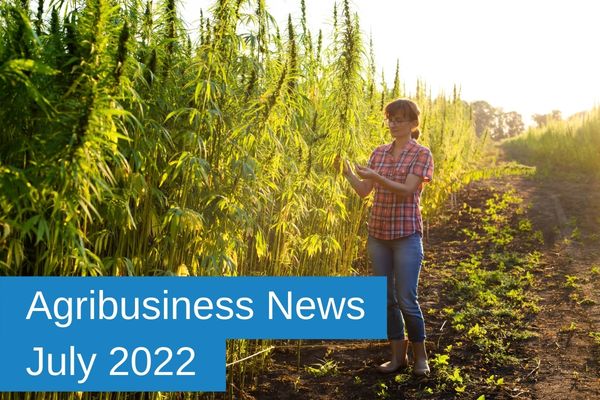Agribusiness News July 2022: New Beginnings – Hemp
30 June 2022Growing’ opportunities for hemp
As industries and economies accelerate decarbonisation, there is an increasing drive towards renewable materials, and consumer interest and demand in natural products and the origins of products.
Once an old favourite for rope production hemp offers a natural source of a vast array of product and co-product opportunities, including construction materials, textiles, plastics, bio-composites, feed, food and supplements, CBD (dual purpose varieties), among many others not yet fully explored.
Benefits to farm businesses
- Improved soil structure
- Water management & erosion control
- Absorption of pollutants
- Effective buffer strips
- Great break crop in arable rotations
- Low input crop, so reduced inputs (& cost)
- Can utilise existing equipment & farm infrastructure
- Could support diversified incomes streams without taking land out of agricultural production.
Recent figures from the ABC Handbook that gross margins for hemp compete with oats, oilseed rape and linseed already, without yet widely established processing for higher value markets.
| Gross Margin | (£ per ha) |
|---|---|
| Hemp | £596 (+) |
| Wheat | £634-916 |
| Barley | £610-653 |
| Oats | £551-695 |
| Oilseed rape | £461-877 |
| Linseed (flax) | £475-642 |
Source: ABC Handbook (2021)
Production & Market Establishment Risks
Recently hemp has been successfully grown in the Scottish Borders, Dumfries, and Galloway, as well as up the East coast of Scotland. While there is a limited (but developing) processing capacity, particularly in Scotland; lack of proximity to processing plants is affecting viability (due to generally bulky and low value crops). However, interest and investment for higher value fibre products and other potential uses may support the economic viability of production and processing.
Hemp vs. Trees for fibre products
A key opportunity for hemp may lie in the fast turnaround for production of construction and fibre materials versus other natural sources e.g., timber.. In addition, we have seen in the last winter how drastically long-term tree stocks can be decimated in increasingly volatile winter storms.
Carbon sequestration & capture potential
With Net Zero targets in mind, hemp may also offer some potential for carbon sequestration and capture, although few and only preliminary studies have been carried out to date. An Australian study estimates that 1.69-2.45 tonnes of CO2e (Carbon dioxide equivalent) could be sequestered per hectare per year. This is in addition to 9-13 tonnes of CO2 absorbed by the crop per hectare per year. However, it is important to note that:
- Actual long term soil carbon sequestration will depend on how the land is managed after the hemp harvest; and
- Only ‘embedded’ carbon in the harvested crop can be considered ‘sequestered’ if it is held in a ‘permanent’ form (for 100+ years – IPCC).
If either of these two conditions were to result in carbon capture or sequestration, hemp could offer potential for the creation of carbon credits – providing yet another incentive for production.
Hemp Climate Benefits:
- Climate mitigation: offsetting fossil fuels (& emissions) à decarbonised products & industry; benefits to agricultural rotations & soils.
- Climate adaptation: increased rotation resilience & farm profitability, reduced fossil fuel dependence.
- Potential carbon sequestration: offsetting capture and creation of creation of carbon credits (further studies required).
anna.sellars@sac.co.uk, 07717 71756
For more up to date market info, see the latest edition of Agribusiness News
Sign up to the FAS newsletter
Receive updates on news, events and publications from Scotland’s Farm Advisory Service

